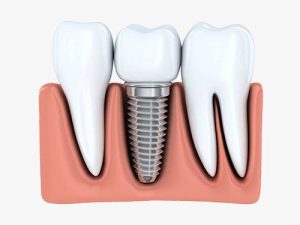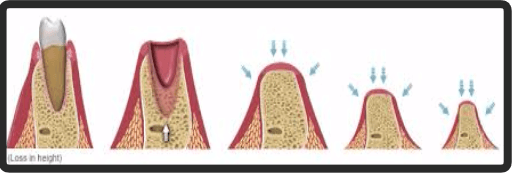 Losing one or more teeth starts a chain of events that can have dire physical and cosmetic consequences. The most obvious result is a gap in your smile.
Losing one or more teeth starts a chain of events that can have dire physical and cosmetic consequences. The most obvious result is a gap in your smile.
Less obvious is the loss of chewing function and the inability to eat a complete diet that can result from tooth loss. While these are serious issues, a potentially bigger problem lies hidden beneath the surface, and that is bone loss.
Your jawbone needs the chewing action of teeth to stimulate and keep it strong.
Otherwise, it will begin to disappear (atrophy) in the same manner that the unused muscles beneath a cast get smaller.
Without the support of your teeth and facial bones, your face will begin to look prematurely old.
The good news is that replacing teeth with dental implants offers a solution to help prevent bone loss.
Although, teeth are rarely lost in this day and age, because of the efforts made to save them. There are a number of reasons why teeth may need to be removed. Here are some:
Unsuccessful root canal treatment
Root canal treatment fails due to reasons such as:
- Persistent infection
- Inadequate root canal treatment
- Diminished success rate of retreatment and related cost
- Fractured roots
- Fractured post and/or broken teeth at along the gum line
Gum disease
When the supporting bone around the teeth is lost to chronic gum disease and infection and teeth drift apart and become loose.
Structural reasons
When teeth have been restored or filled heavily due to a lot of decay or due to severe wear and attrition.
Incorrect positioning
Either severe mispositioning resulting in having to remove tooth and root.
Missing teeth
Especially the upper lateral incisor teeth or even other congenitally missing teeth. Dental implants replace lost tooth with an artificial root that is made of titanium. This procedure can be used to replace one tooth, several teeth or all the teeth
Dental Implants: How do they work?

To understand how dental implants work, it is important to understand how a socket heals after tooth extraction.
Once a tooth is removed, the hole left in the bone gets filled up with a blood clot.
The bone grows into this clot from below and from the sides, and as the gum tissue only takes 6-8 weeks to close together, the bone continues to get formed in the socket and matures over a period of 6 months.
Similarly, healing of implants depends on this natural process.
To place a dental implant/s, a small incision is made in the soft tissue gum to expose the bone — sequential preparation with the use of special drills.
Then the titanium implant is placed, and the gum stitched over and the implant allowed to fuse to the bone undisturbed.
Denture wearers can continue to wear their dentures throughout this time. In cases where a few teeth have been removed and other teeth present, it is possible to construct a fixed temporary bridge to enable the patient to function.
There is, however, either no interruption or very little inconvenience to the patient’s lifestyle.
The second phase of treatment is usually commenced after 4 to 6 months, where if necessary, the dental implant/s are exposed and healing caps or temporary gum forming restorations attached.
Following tissue healing within 2-4 weeks, final impressions are made, and the final definitive prosthetic replacements attached.
Regular visits at 4-6-week intervals during healing are necessary to review and keep a check on the healing, and also once the final restorations have been fitted, on a 3-monthly basis.
Dental Implants Options in Wantirna South
Fixed or Removable Implant-Supported Crowns (Single)
Benefits of Implant-Supported Crown:
- Looks, feels and functions like a natural tooth
- Does not compromise adjacent teeth (no enamel reduction)
- Preserves bone hygienically
- Prevents bone collapse
- Long-lasting and stable
Multiple Teeth Replacement
Dental implants can also be used to replace several missing teeth, eliminating the need to grind down healthy adjacent teeth to serve as posts for traditional crown and bridge.
The implants are placed in the bone below the gum tissue. Like single tooth replacement, temporary abutments may be placed on the implants until the healing phase is complete.
After healing is complete, generally within 4-6 months, the abutments are attached to the implants, or impressions taken and custom abutments fabricated, and the dental laboratory will fabricate teeth either using porcelain fused to metal, or all-ceramic crowns, and these are either screwed into the implants or cemented onto abutments.
Removable Full-Arch Implant-Supported Prosthesis
If all your lower teeth are missing, 4 to 5 implants may be used to support a lower denture.
If all your upper teeth are missing, 6 or more implants may be used to support an upper denture.
The dental implants are inserted surgically below the gum and into the bone and given time to fuse with the bone. Temporary abutments may be placed on the implants until the healing phase is complete.
Your existing denture can be modified so that it may be worn without disturbing the implants during the healing process.
Upon completion, a custom-made cast bar with cones is fabricated to fit precisely over the implants and your new fixed/removable prosthesis and veneered over this.
The new denture will have attachments which snap or clip it into place. Your teeth are firmly supported by the jaw, stimulating it and halting bone loss. You will be able to remove the denture easily for cleaning.
Research has shown that implant-supported prosthesis increases patient comfort and enhance the quality of life.
Fixed Implant-Supported Prosthesis
If all your upper or lower teeth are missing, a permanent bridge may be attached directly to the plants. The number of implants is determined by the specific requirements of each case.
The implants are surgically placed below the gum and into the bone and given time to fuse to the bone.
Temporary healing abutments are placed over these implants and your existing dentures modified to fit over these, without disturbing the healing of the implants beneath.
Upon completion of healing, you are fitted with a custom bridge (denture) that screws directly into the implants. The screw holes are covered after insertion.
Your new teeth are firmly supported by the jaw, stimulating it and halting bone loss.
Your Wantirna South dentist will be able to remove the prosthesis when necessary for cleaning and maintenance.
Lower Denture Stabiliser
If all your lower teeth are missing, 2 to 4 implants may be used to stabilise a lower denture.
2 implants or 4 mini implants are placed surgically below the gum and into the bone and allowed to heal. These can often be loaded immediately depending on the stability attained during placement.
Ball-top posts are attached to the implants. Your old dentures may be modified to hold clips that snap over the ball-tops, or a new denture with clips will be made.
The denture is snapped into place, where it is retained by the implants and supported by the soft tissue. You simply snap the denture out for cleaning.
In cases when good dental care, routine hygiene maintenance, and regular trips to the dentist are not enough to prevent, dental implants might be best option to restore your gapped smile and avoid the negative implications of lost teeth.
If you are exploring your options for dental implants in Wantirna South, Dr Sheetal Sachdeva can help create the best treatment plan, so you can get your dental implants Wantirna South installed and your smile restored in no time.
Dental Implants Wantirna – Why You Should Consider Permanent Teeth Replacement?
Implants help as permanent replacements for missing teeth. While teeth falling out due to age may seem inevitable, it doesn’t have to be a fact of life you have no choice but accept.
Thanks to advancements in dentistry and dental implantation, there are safe ways by which you can remedy tooth loss, be it due to old age or some other dental damage.
Upon visiting our Wantirna South clinic, Dr Sachdeva will take a look at your condition and prescribe different treatment options that you can choose from.
Depending on your general health the condition of your teeth, your goals, and your budget, he will typically give you multiple treatment options based on the best approaches to restoring your dental health and explain each so that you can make an informed decision.
Certificates on Dental Implants
- Osseointegrated Dental Implant Course – Osseointegration and Clinical Dentistry in Reconstruction of the Edentulous Mouth at University of Sheffield, March 1988
- Advanced Surgery Course on Tissue Integration at Trinity College in Dublin and Blackrock Clinic Dublin under Professor Per-Ingvar Brånemark (Father of Modern Dental Implantology), September 1988
- Participated in a course on Tissue Integrated Implants, utilising procedures in the Osseointegration Technique with the Brånemark System in Melbourne, March 1993
- Applied Anatomy Course in Oral Implantology at the Department of Anatomy and Surgical Training Centre at University of New South Wales, 2006
- State-of-the-Art Augmentation Procedures in Oral Implantology at the Royal Australasian College of Surgeons in Melbourne under Aesculap Academy (Dr Alex Fibishenko and Prof Dr Daniel Buser), October 2007
- 1-year UCLA/gIDE Master Program in Implant Dentistry at University of California Los Angeles School of Dentistry, January-December 2009
- Attended Beyond the Basics – Expanding Implant Treatment Possibilities presented by Dr Howard Gluckman, May 2012
- Attended Digital Diagnostics and Treatment Planning in Sydney under Nobel Biocare, April 2011
- Attended Complication Management by Dr Yong Seek Cho with Osstem Implants in Seoul, South Korea, January 2016.
Dental implants, although pricier than most other treatments, make the best treatment option for lost teeth because they help restore more than your smile—they also essentially reconstruct the lost tooth so as to compensate for lost functions.
In addition to restoring your ability to chew and eat a complete diet, you also combat problems that lie beneath the surface such as bone loss and muscle atrophy that results from the lack of stimulation from the natural chewing action.
Not only you will experience weakening of your facial bones—but your face will also begin to sink quite prematurely due to bone and muscle loss.
Dental Implants in Wantirna South
No other type of tooth restorations can bring back the function and structure like dental implants in Wantirna South.
This is why at Dr Sachdeva’s dental clinic, implantation comes highly recommended as a treatment for tooth loss whether you need single or multiple teeth replacements or perhaps an efficient means to stabilise dentures or get a complete upper/lower teeth restoration in Wantirna South. Dental implants offer the perfect solution for missing teeth.
Dental Implants in Wantirna South
Call us on (03) 9800 2338 or book your appointment online.
We are located at 287 Stud Road in Wantirna South.
